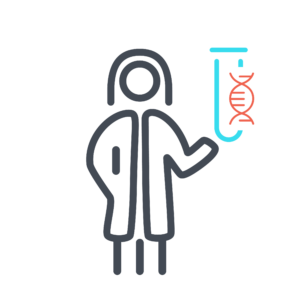UPF3B-Related Syndrome

Table of contents
- What is UPF3B-related syndrome?
- Key Role
- Symptoms
- What causes UPF3B-related syndrome?
- Why does my child have a change in the UPF3B gene?
- What are the chances that other family members of future children will have UPF3B-related syndrome?
- How many people have UPF3B-related syndrome?
- Do people who have UPF3B-related syndrome look different?
- How is UPF3B-related syndrome treated?
- Behavior and development concerns linked to UPF3B-related syndrome
- Medical and physical concerns linked to UPF3B-related syndrome
- Where can I find support and resources?
- Sources and References
UPF3B-related syndrome is also called UPF3B-related disorder or intellectual developmental disorder, X-linked syndromic 14. For this webpage, we will be using the name UPF3B-related syndrome to encompass the wide range of variants observed in the people identified.
What is UPF3B-related syndrome?
UPF3B-related syndrome happens when there are changes in the UPF3B gene. These changes can keep the gene from working as it should.

Key Role
The UPF3B protein plays an important role in processing RNA in the cell and in the development and function of the brain.
Symptoms
Because the UPF3B gene is important for brain activity, many people who have UPF3B-related syndrome have:
- Developmental delay
- Intellectual disability
- Autism
- Attention-deficit hyperactivity disorder (ADHD)
- Schizophrenia
- Seizures
- Speech delay or impairment
- Low muscle tone
- Brain changes seen on magnetic resonance imaging (MRI)
What causes UPF3B-related syndrome?
UPF3B-related syndrome is a genetic condition, which means that it is caused by variants in genes. Our genes contain the instructions, or code, that tell our cells how to grow, develop, and work. Genes are arranged in structures in our cells called chromosomes. Chromosomes and genes usually come in pairs, with one copy from the mother, from the egg, and one copy from the father, from the sperm.
We each have 23 pairs of chromosomes. One pair, called the X and Y chromosomes, differs between biological males and biological females. Biological females have two copies of the X chromosome and all its genes, one inherited from their mother and one inherited from their father. Biological males have one copy of the X chromosome and all its genes,inherited from their mother, and one copy of the Y chromosome and its genes, inherited from their father.
In most cases, parents pass on exact copies of the gene to their child. But the process of making the sperm and egg is not perfect. A variant in the genetic code can lead to physical issues, developmental issues, or both.
The UPF3B gene is located on the X chromosome, so variants in this gene can affect biological males and biological females in different ways. Biological males who have variants in this gene will likely have UPF3B-related syndrome.
Biological females who have variants in this gene may or may not have symptoms of UPF3B-related syndrome. Biological females who have one working copy of the gene and one non-working copy are considered to be ‘carriers’. Even if a biological female does not have signs or symptoms of the syndrome, they can pass it along to their children.
X-linked recessive conditions
UPF3B-related syndrome sometimes is the result of an inherited variant in UPF3B. This means a UPF3B genetic variant that was passed down from a biological female parent. Biological females who carry the UPF3B variant sometimes have symptoms.
X-Linked Recessive Genetic Syndrome
Why does my child have a change in the UPF3B gene?
No parent causes their child’s UPF3B-related syndrome. We know this because no parent has any control over the gene changes that they do or do not pass on to their children. Please keep in mind that nothing a parent does before or during the pregnancy causes this to happen. The gene change takes place on its own and cannot be predicted or stopped.
What are the chances that other family members of future children will have UPF3B-related syndrome?
Each family is different. A geneticist or genetic counselor can give you advice on the chance that this will happen again in your family.
The risk of having another child who has UPF3B-related syndrome depends on the genes of both biological parents.
X-linked recessive conditions
- Biological females who have a variant in the UPF3B gene and are pregnant with a daughter have a 50 percent chance of passing on the same genetic variant and a 50 percent chance of passing on the working copy of the gene.
- If they are pregnant with a son, the child has a 50 percent chance of inheriting the genetic variant and the syndrome.
For a symptom-free brother or sister of someone who has UPF3B-related syndrome, the sibling’s risk of having a child who has UPF3B-related syndrome depends on the sibling’s genes and their parents’ genes.
- If neither parent has the same genetic variant causing UPF3B-related syndrome, the symptom-free sibling has a nearly 0 percent chance of having a child who would inherit UPF3B-related syndrome.
- If the biological mother has the same genetic variant causing UPF3B-related syndrome, and the symptom-free daughter has the variant, the symptom-free daughter’s chance of having a son who has UPF3B-related syndrome is 50 percent.
For a person who has UPF3B-related syndrome, the risk of having a child who has the syndrome is about 50 percent.

How many people have UPF3B-related syndrome?
As of 2025, about 43 people with UPF3B-related syndrome have been identified in medical research.

Do people who have UPF3B-related syndrome look different?
People with UPF3B-related syndrome may look different. Appearance can vary and can include some but not all of these features:
- Smaller than average head size
- Thin body type and tall height
- Longer than average face
- Sideways curve of the spine, also called scoliosis
- Forward rounding of the upper back

How is UPF3B-related syndrome treated?
Scientists and doctors have only just begun to study UPF3B-related syndrome. At this point, there are no medicines designed to treat the syndrome. A genetic diagnosis can help people decide on the best way to track the condition and manage therapies. Doctors can refer people to specialists for:
- Physical exams and brain studies
- Genetics consults
- Development and behavior studies
- Other issues, as needed
A developmental pediatrician, neurologist, or psychologist can follow progress over time and can help:
- Suggest the right therapies. This can include physical, occupational, speech, or behavioral therapy.
- Guide individualized education plans (IEPs).
Specialists advise that therapies for UPF3B-related syndrome should begin as early as possible, ideally before a child begins school.
If seizures happen, consult a neurologist. There are many types of seizures, and not all types are easy to spot. To learn more, you can refer to resources such as the Epilepsy Foundation’s website: www.epilepsy.com/learn/types-seizures.

This section includes a summary of information from published articles. It highlights how many people have different symptoms. To learn more about the article, see the Sources and References section of this guide.
Behavior and development concerns linked to UPF3B-related syndrome
The UPF3B gene is located on the X chromosome. Chromosomes are structures in our cells that house our genes. Only males who carry the genetic variation have the condition.
Speech and learning
Most males with UPF3B-related syndrome had developmental delay or intellectual disability. Some males had speech and/or language impairment.
- 41 out of 43 people had developmental delay or intellectual disability (95 percent)
- 10 out of 42 people had speech and/or language impairment (24 percent)
Behavior
Males with UPF3B-related syndrome had behavioral issues, such as features of autism, attention-deficit/hyperactivity disorder (ADHD), repetitive behavior, or abnormal aggressive, impulsive, or violent behavior.
- 10 out of 42 people had autism or features of autism (24 percent)
- 3 out of 42 people had ADHD (7 percent)

Brain
Some males with UPF3B-related syndrome had neurological medical issues, including seizures, low muscle tone (hypotonia), movement defects, a smaller than average head size (microcephaly), and brain changes seen on magnetic resonance imaging (MRI). Two people have been reported to have schizophrenia, and one person had childhood onset schizophrenia.
- 9 out of 42 people had seizures (22 percent)
- 9 out of 42 people had hypotonia (22 percent)
- 6 out of 12 people had brain changes seen on MRI (50 percent)
- 2 out of 42 people had schizophrenia (5 percent)

Graphs
100%
80%
60%
40%
20%
0
Medical and physical concerns linked to UPF3B-related syndrome
Other medical findings included vision issues, sideways curve of the spine (scoliosis) and/or forward rounding of the upper back (kyphosis), or a larger than average head size (macrocephaly).
- 8 out of 42 people had vision issues (19 percent)
- 9 out of 42 people had scoliosis and/or kyphosis (21 percent)

Where can I find support and resources?
Simons Searchlight
Simons Searchlight is an online international research program, building an ever growing natural history database, biorepository, and resource network of over 175 rare genetic neurodevelopmental disorders. By joining their community and sharing your experiences, you contribute to a growing database used by scientists worldwide to advance the understanding of your genetic condition. Through online surveys and optional blood sample collection, they gather valuable information to improve lives and drive scientific progress. Families like yours are the key to making meaningful progress. To register for Simons Searchlight, go to the Simons Searchlight website at www.simonssearchlight.org and click “Join Us.”
- Learn more about Simons Searchlight: www.simonssearchlight.org/frequently-asked-questions
- Simons Searchlight webpage with more information on UPF3B: www.simonssearchlight.org/research/what-we-study/upf3b
- Simons Searchlight UPF3B Facebook community: https://www.facebook.com/groups/upf3b

Sources and References
- Laumonnier, F., Shoubridge, C., Antar, C., Nguyen, L. S., Van Esch, H., Kleefstra, T., Briault, S., Fryns, J. P., Hamel, B., … & Raynaud, M. (2010). Mutations of the UPF3B gene, which encodes a protein widely expressed in neurons, are associated with nonspecific mental retardation with or without autism. Molecular Psychiatry, 15(7), 767-776. doi:10.1038/mp.2009.14
- Romano, F., Haanpää, M. K., Pomianowski, P., Peraino, A. R., Pollard, J. R., Di Feo, M. F., Traverso, M., Severino, M., Derchi, M., … & Scala, M. (2024). Expanding the phenotype of UPF3B-related disorder: Case reports and literature review. American Journal of Medical Genetics Part A, 194(6), e63534. doi:10.1002/ajmg.a.63534
- Tarpey, P. S., Raymond, F. L., Nguyen, L. S., Rodriguez, J., Hackett, A., Vandeleur, L., Smith, R., Shoubridge, C., Edkins, S., … & Gécz, J. (2007). Mutations in UPF3B, a member of the nonsense-mediated mRNA decay complex, cause syndromic and nonsyndromic mental retardation. Nature Genetics, 39(9), 1127-1133. doi:10.1038/ng2100
- Tejada, M. I., Villate, O., Ibarluzea, N., de la Hoz, A. B., Martínez-Bouzas, C., Beristain, E., Martínez, F., Friez, M. J., Sobrino, B., & Barros, F. (2019). Molecular and clinical characterization of a novel nonsense variant in Exon 1 of the UPF3B gene found in a large Spanish Basque family (MRX82). Frontiers in Genetics, 10, 1074. doi:10.3389/fgene.2019.01074
